

Who would believe that this patient, Zhou Bin, who is able to make this "I'm ok" gesture to the camera and to hold a pen to write on the mobile phone, underwent
China's first combined double lung and liver transplant just one day before.
UPDATE: THE PATIENT IS DISCHARGED FROM SAHZU ON MAR 25, 2021.
Zhou Bin (also known as Zou Xin in previous reports) had a new pair of life-saving lungs and a new liver at SAHZU on Feb. 27, 2021. The combined surgery marked a milestone for the SAHZU transplant program, also the first of its kind ever performed in the whole country.
Even in the world, the combined double lung and liver transplant is very rare. It is a highly difficult operation not only in the organ transplant itself but also in the perioperative management. Only a few cases have been reported outside China so far. Despite of its huge challenge, it is the last life-saving straw for patients with late-stage lung diseases and liver diseases.
Zhou Bin, a mid-forty male patient, since diagnosed to have lung fibrosis five years ago, has never stopped fighting for his life. However, over the past year, his condition deteriorated so much that he had to rely on oxygenation therapy, lying on bed all day.
Zhou Bin was transferred to SAHZU on Feb. 22 by ambulance. With the high flow oxygenation therapy, his blood oxygen level was only 80%, which put him in a critical condition that can only be saved by double lung transplant. To make things worse, Zhou Bin also had severe cirrhosis and hepatic failure.
He was exanimated thoroughly at SAHZU. Members of SAHZU transplant team all agreed that he needs an immediate lung transplant because of his late-stage lung fibrosis, pulmonary hypertension, and right ventricular dysfunction. Meantime, he was suffering from a bad hepatic function with gastrointestinal varices and variceal hemorrhage, which would require a new liver too.
When a lung transplant or a liver transplant alone couldn't save Zhou Bin's life, SAHZU surgeons decided to rise up to the challenge by performing China's first combined double lung and liver transplant urgently.
SAHZU's multidisciplinary transplant team spent a lot of time planning for Zhou Bin's complex surgery. After many times' consultation and discussion, a detailed surgery plan down to every minute was schemed for him.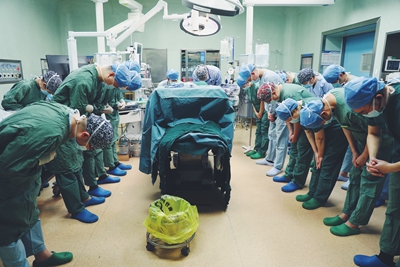
A relay race for life happened quietly in the SAHZU operating theater on Feb. 27.
7:30 AM: The donor was brought to the operating room where her liver, lungs, heart, kidneys and cornels were harvested to save others. Doctor and nurses made a deep bow to the donor.
7:40 AM: In a nearby operation room, doctors began to anesthetize Zhou Bin.
9 AM: Chair of SAHZU Thoracic Surgery Prof. WU Ming and his lung transplant team, along with Prof. CHEN Jingyu, the Chairman of Transplant Committee of Chinese Medical Association and a special consultant to this operation, made the first incision on Zhou Bin's chest. This unprecedented task for the SAHZU lung transplant team started. Multi-organ transplant demands close and well-organized collaboration between multiple surgical teams.
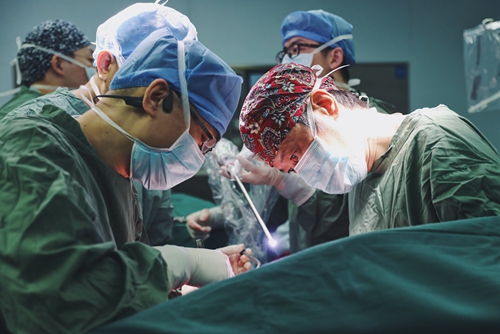 In Zhou Bin's case, his failing heart and lung function decided that the best approach for his surgery, is to perform the lung transplant first to improve his blood oxygen level, so that he can undergo the liver transplant and be removed from life support postoperatively sooner.
In Zhou Bin's case, his failing heart and lung function decided that the best approach for his surgery, is to perform the lung transplant first to improve his blood oxygen level, so that he can undergo the liver transplant and be removed from life support postoperatively sooner.
11:58 AM: The pulmonary artery and veins of patient's both lungs were connected. The donor lungs started to work right away.
12:20 PM: SAHZU President Prof. WANG Weilin, Vice Chair of General Surgery Prof. YAN Sheng, Dr. SHI Yanjun and the liver transplant team opened up the patient's abdomen to access the liver.
4 PM: The liver transplant was successfully completed.
6:30 PM: the extracorporeal membrane oxygenation (ECMO) machine was disconnected from the patient.
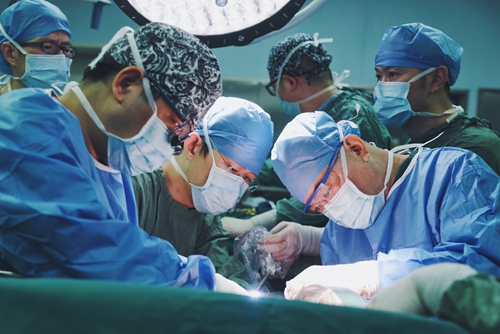 "It is a difficult surgery," Prof. WANG commented. "The patient has a very bad cirrhosis and his intraoperative hemodynamics was unstable due to portal vein thrombosis and collateral circulation, making the procedure even harder. But our team still did an excellent job."
"It is a difficult surgery," Prof. WANG commented. "The patient has a very bad cirrhosis and his intraoperative hemodynamics was unstable due to portal vein thrombosis and collateral circulation, making the procedure even harder. But our team still did an excellent job."
"This surgery is the first of its kind in China. From the first chest incision to closing up the abdomen, it took us more than 10 hours. We should and will summarize and treasure this rare experience," Prof. WANG added. "I believe that our transplant teams will keep perfecting our skills and performing more and harder transplant operations. Our goal is to be able to stand in the leading position in the world in future."
For SAHZU Anesthesiology, the task is same grim. During the whole procedure, the anesthesiology team led by Chair Prof. YAN Min never left the operating theater.
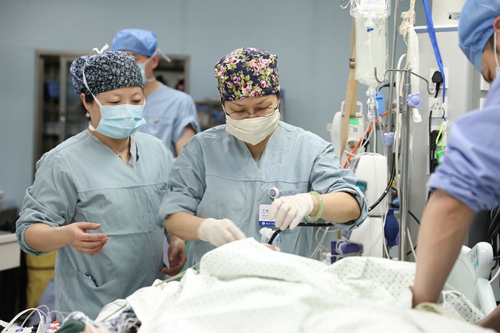 The surgery plan of lung transplant followed by liver transplant would put the new pair of donor lungs under great pressure. The patient's blood oxygen level, pulmonary artery pressure and cardiopulmonary function need to be monitored closely and intervened in advance if necessary. Thanks to the fully prepared anesthesiology team, careful plans are designed for all foreseeable scenarios.
The surgery plan of lung transplant followed by liver transplant would put the new pair of donor lungs under great pressure. The patient's blood oxygen level, pulmonary artery pressure and cardiopulmonary function need to be monitored closely and intervened in advance if necessary. Thanks to the fully prepared anesthesiology team, careful plans are designed for all foreseeable scenarios.
8:20 PM: After almost 13 hours'operation, Zhou Bin was brought into the intensive care unit with stable vital signs. What lying ahead of him, are risks of postoperative complications, and also hope of new life.
For Prof. HUANG Man and her Intensive Care Unit, however, the relay race stick was just handed over to their hands. Postoperative management of a transplant patient is like walking on a high-wire that requires extreme carefulness, because the complicated association between hepatopulmonary syndrome and pulmonary hypertension would double the risks of postoperative complications after lung and liver transplant.
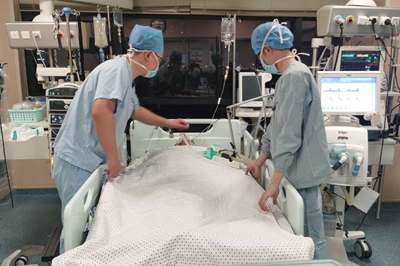 First, the requirements of proper fluid resuscitation and mechanical ventilation for lungs and for liver are completely different from each other, which forces the transplant team to find out a perfect balancing point in the dilemma in the anesthesia and perioperative management. Second, the two new organs might hold each other back if there is reperfusion syndrome and possible acute infections caused by immunosuppression, increasing the difficulty of management.
First, the requirements of proper fluid resuscitation and mechanical ventilation for lungs and for liver are completely different from each other, which forces the transplant team to find out a perfect balancing point in the dilemma in the anesthesia and perioperative management. Second, the two new organs might hold each other back if there is reperfusion syndrome and possible acute infections caused by immunosuppression, increasing the difficulty of management.
Author:LI JING | Reviewer:LI JING | Editor:LI JING | Source:General Surgery, Anesthesiology, ICU | Date:2021-02-28 | Views:![]()
![]()